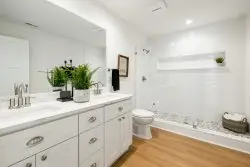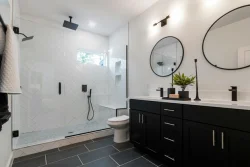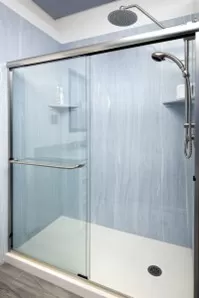Your Tub Guide from the Experts!
General tub facts
- The standard size for a tub is 60” X30”, or it may also be 60” X32
- Although these are the most commonly sized tubs, some tubs can have a width of 54”, and others can be 36” in wall depth.
- It is important to know how much space you are working with, and what size tub is best for you.
- Part of the tub is HIDDEN behind the wall, making the tub slightly larger than what a tape measure might tell you, so don’t worry if your tape says 59”X29”. This is a 60”X30” tub.
- If your tape says 59”X30” or 59”X31”, this is most likely a 60”X32” tub.
- The “overflow” is the name of the metal piece towards the top of the tub. It helps reduce the amount of water in the tub if it is overfilled.
- Most tubs have a circular overflow.
- A linear overflow allows for a deeper soak.
- Your “soaking depth” on the specification sheet of the tub is to the center of the overflow.
- Most tubs have a circular overflow.

60” wide tub measurement

Linear overflow, also known as horizontal overflow
Acrylic VS Steel
- The two most common materials used on tubs are steel and acrylic. Both come with their own pros and cons.
- What are the pros and cons of a steel tub?
- Steel tubs are the stronger material of the two. Tub Cove puts a mortar base under every tub we install, so either material you chose will be reinforced, but some people want that extra peace of mind.
- Steel tubs are better at resisting scratches, but the enamel coating can chip off over time.
- Steel tubs are not used as much as acrylic tubs in the modern day, because they are an older style. This means you are limited in soaking depth and various sizes.
- What are the pros and cons to acrylic tubs?
- Acrylic tubs are usually well insulated, allowing for longer heat retention.
- Although steel tubs keep heat in also, acrylic tubs tend to have better insulation.
- Acrylic tubs are starting to become a norm, so there is a large variation in size and soaking depth.
- Acrylic tubs offer a more modern look. The acrylic tub has sharper edges, giving it a more contemporary look. Steel tubs tend to have rounded corners.
- Acrylic tubs are usually well insulated, allowing for longer heat retention.

Steel Alcove tub

Acrylic free-standing tub
Free-standing tubs
A free-standing bathtub is a tub that stands on the floor with no walls immediately surrounding it. These tubs are generally put in large, open-spaced bathrooms, but can be cleverly fit into smaller spaces, since it is not limited to being inside a framed in area like other tubs are.
- Free-standing tubs are the most contemporary and modern option on the market. Because of such high demand, they are made in almost any design you can think of.
- Free-standing tubs have the most shape and size variety out of all the different styles of tubs.
- The basic styles of free-standing tubs are oval or rectangle, but you can get more unique shapes, like slipper style, circular, or even tubs that look like basins.
- Although most free-standing tubs are acrylic, there are an assortment of materials they can be made in. Some people prefer a cast iron tub, which will last a lifetime (80-100 years.) However, cast iron tubs are incredibly heavy and difficult to install, as well as maintain.
- o For people that are looking for a more unique look, there are other, heavier, materials on the market. You can get tubs made of stone, faux marble, even real marble, and countless other materials.
- Because you are not limited to the wall space around the tub, your freestanding tub can be as large as your space will allow. This opens many options for shapes, and if you want a one-person tub or a two-person tub.
- A free-standing tub doesn’t usually work with a shower head, but there are options.
- While sometimes there are shower heads over a free-standing tub, it is uncommon. A standard free-standing tub is not ideal for a shower since it does not have the same water-proofing surround that an alcove tub or walk-in shower would have.
- When a free-standing tub does have a shower head, the tub can often be surrounded by a circular shower curtain, to enclose the tub space and reduce splashing.
- Ordinarily, if you want the functions of both a tub and a shower in one bathroom, then there would be a separate shower stall in the bathroom.
- Some bathrooms have a giant, tiled shower, and inside of the giant shower is a free-standing tub. This is a stunning design, although a lot of space (and tile) is required for this to work.
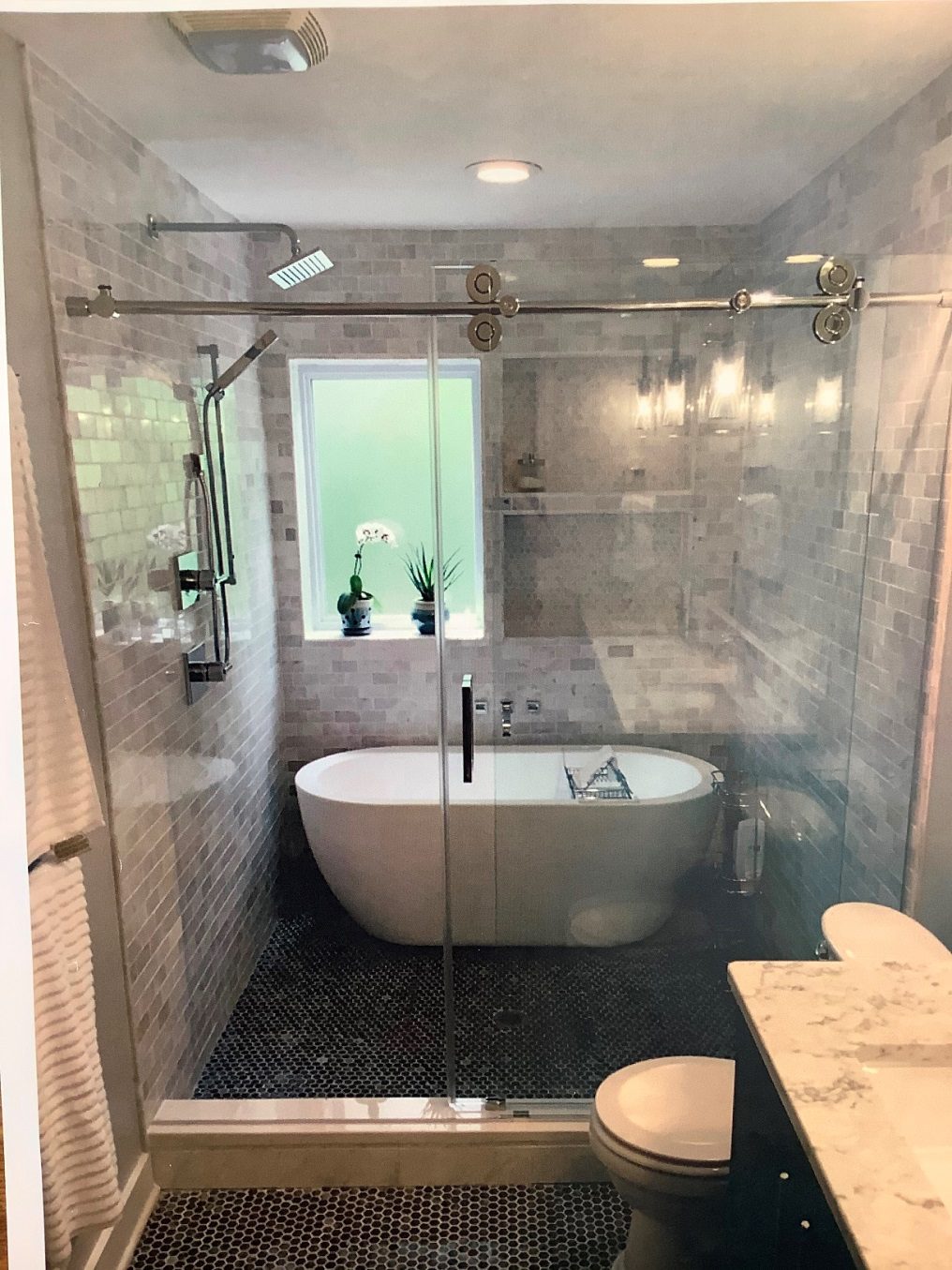
Free-standing tub inside of large shower
- You are only limited to plumbing and the location of mechanical systems when it comes to a spot for your freestanding tub. Some bathrooms have the tub in the middle of the bathroom, or off to the side.
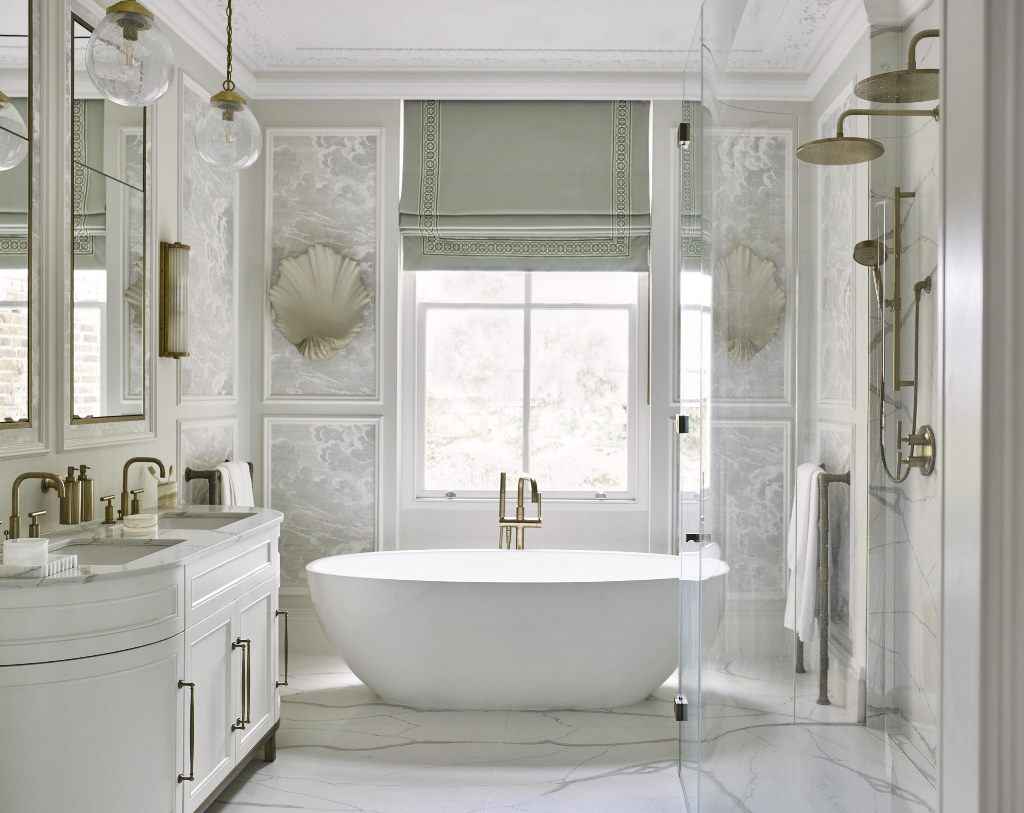
European style bathroom with centered freestanding tub
- A free-standing tub requires a specific tub spout called a Floor Mounted Faucet. These are installed into the floor next to the tub and are taller than the height of the free-standing tub, so that the water can freely flow into the tub.
- Like all plumbing fixtures, a free-standing tub requires a valve. The valve is the plumbing component you do not see, and it controls the water flow and temperature. There is direct compatibility needed between the valve and the floor mounted faucet. If you need help determining the compatibility, your Tub Cove designer will be happy to help.
- Most free-standing tubs come with a floor mounted faucet, or the website may have options in the recommended section by the listing of the tub.

Slipper Style free-standing tub

Marble free-standing tub

Free-standing tub with circular shower curtain rod

Open style free-standing tub next to large walk-in shower

Matte Black floor mounted faucet
Drop in tubs
- Drop-in tubs are an older style of tub and is a large tub that has been dropped into a framed-out shell. The tub is placed into the hole in the framing, and the framing is topped with a tile or solid surface material.
- Although drop-in tubs aren’t installed as often as they used to be, they are still the ideal solution for a two-person tub, as they come in a large variety of sizes.
- Because the drop-in tubs come in so many different sizes, it is ideal to custom make the framing to match the tub.
- Sleek look
- Drop-in tubs only show the top of the tub, and not the sides. This makes for a sleek and clean design, with lots of opportunity to spice up the bathroom with the material you put on the drop-in tubs framing.
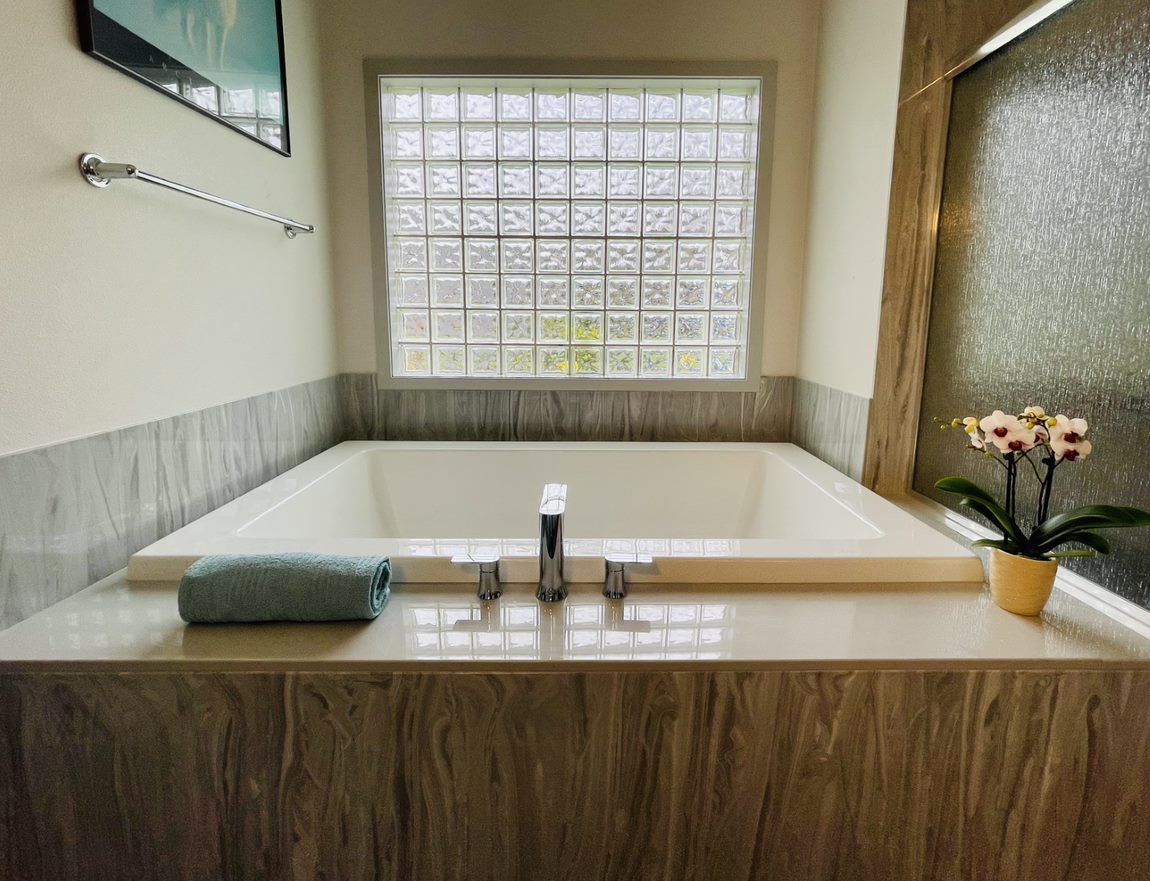
Drop-in tub with Solid Surface project in Issaquah
- Lots of design opportunity.
- A waterproof material needs to be placed over the wooden framing of the tub. Luckily, there are lots of options for the material around the tub.
- Most people tile the outside of the tub framing. Tile offers the most versatility in color and design, but it is difficult to clean.
- People also like to install an Engineered Stone or solid surface material around the tub. This is much easier to clean than a tile with grout, and you have a sleeker, smoother look with a solid surface.
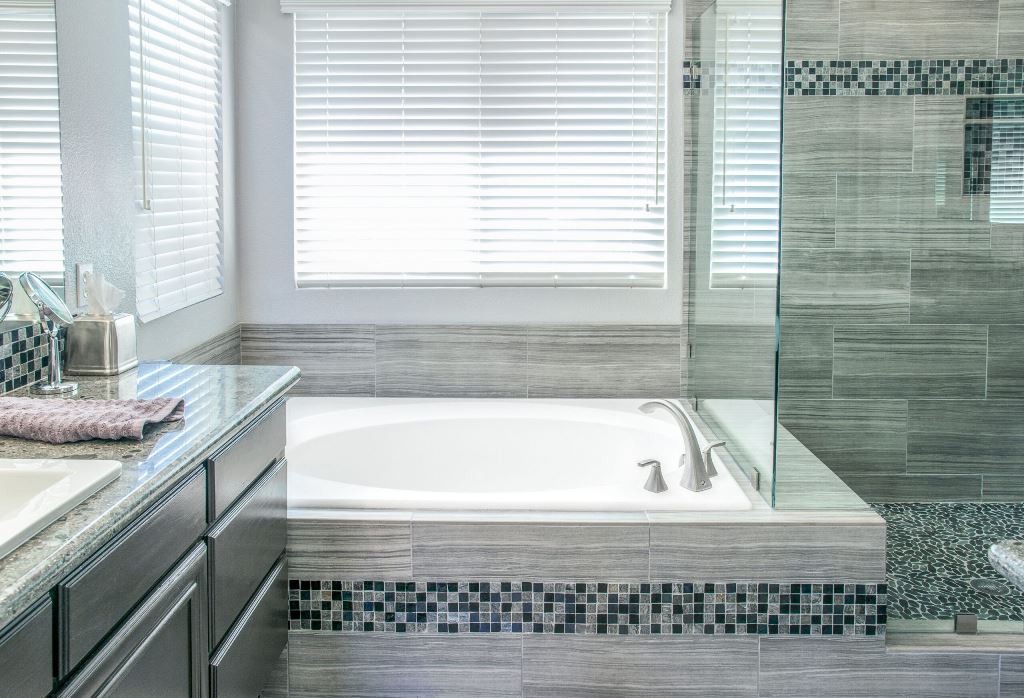
Drop in tub with tiled framing
- A waterproof material needs to be placed over the wooden framing of the tub. Luckily, there are lots of options for the material around the tub.
- Some Drop-in tubs are dropped directly into the floor, so that the top of the tub is nearly flush with the floor.

Tub dropped directly into the floor
Alcove tubs
- Alcove tubs are placed in a “cove”, between two walls with a larger wall in the back.
- The “left” and “right” walls are orientated for when you are in front of the tub. The left wall is the wall to your left when you are looking at the tub.
- Only one side of the tub is visible, commonly referred to as the apron.
- If you need to have a tub in the home for resale value, an alcove tub is the best option, as it will be easier to bathe children in.
- If you want a shower in combination with your tub, the alcove tub is the ideal option.
- Because an alcove tub is surrounded by walls, the size options are limited.
- Alcove tubs can range from a width of 54” -60”, and a wall depth of 30” – 34”.
- The soaking depth of an alcove tub generally ranges from 9” – 20”.
- There isn’t much variation in the look of the alcove tubs, however, can get tubs that can have the apron tiled, which adds more design opportunity.
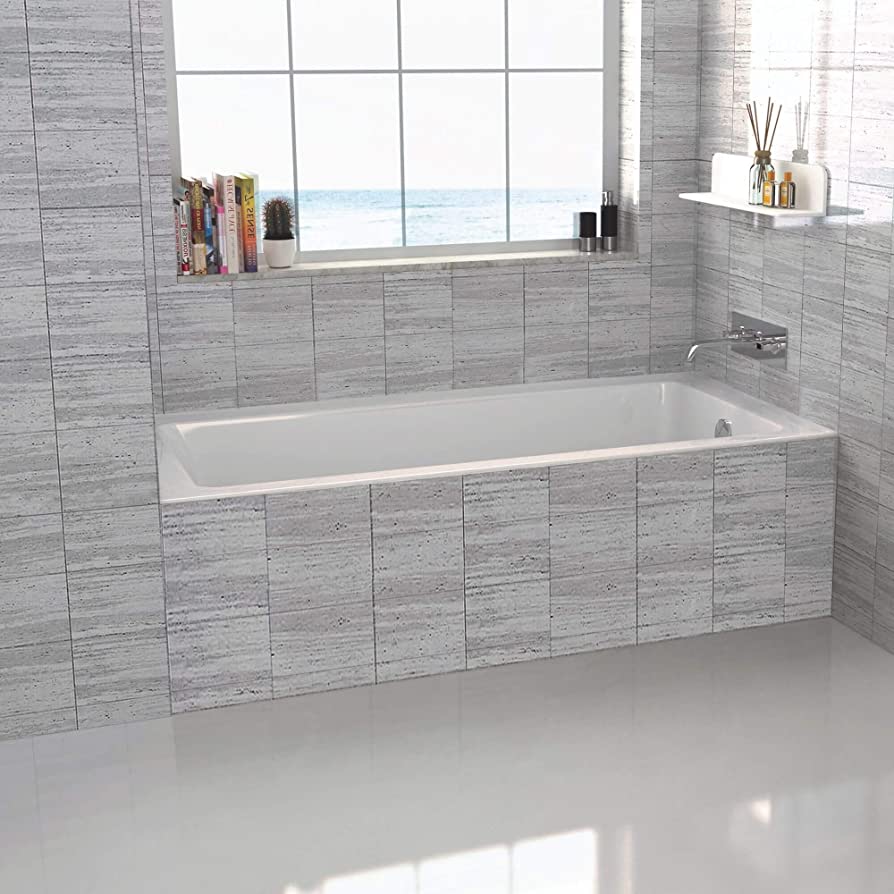
Alcove tub with tiled apron and surround
- Alcove tubs are the best for families.
- When bathing children or dogs, the alcove tub is the best choice.
- Leaning over a free-standing, drop-in, or walk-in tub can be painful and feel awkward.
- When bathing children or dogs, the alcove tub is the best choice.
Walk in tubs
- Walk-in tubs are often alcove, and helpful for those with disabilities. You enter the tub through a door and see the seat. About half of the tub is taken up by the seat, and the other half is open for your feet and legs.
- The walk-in tub doors can swing inwards or outwards. There are advantages and disadvantages to each.
- The outward swing door is better for accessibility.
- An outswing door provides more space in the tub opening, making it easier to enter and exit the tub.
- The outswing door also makes it easier to transition from a wheelchair, scooter, etc. into the tub.
- The inward swing door is better in limited space.
- If your bathroom is smaller, or not equipped for a walk-in tub, then fitting an outswing walk-in tub may take up too much space in the bathroom when opening and closing the tub door.
- The outward swing door is better for accessibility.
- Walk-in tubs often have jets and hydrotherapy options.
- Jets and hydrotherapy are great options for people with arthritis, or other bodily pains.
- Some walk-in tubs also have aroma therapy and calming colored lights as well.
- Walk-in tubs can be used as showers as well!
- Although it may be a little awkward when standing, walk-in tubs are capable of doubling as a shower. If there is proper waterproofing material on the walls, it’s not an issue!

Demonstration of walk-in tub

Walk-in tub with rain shower head
There are endless options for tubs on the market. Whether you want a simple acrylic Alcove tub, or a custom-made marble free-standing tub, there is a selection for any bathroom remodel. If you need further help identifying the right tub for you, the Tub Cove team will be happy to help!






